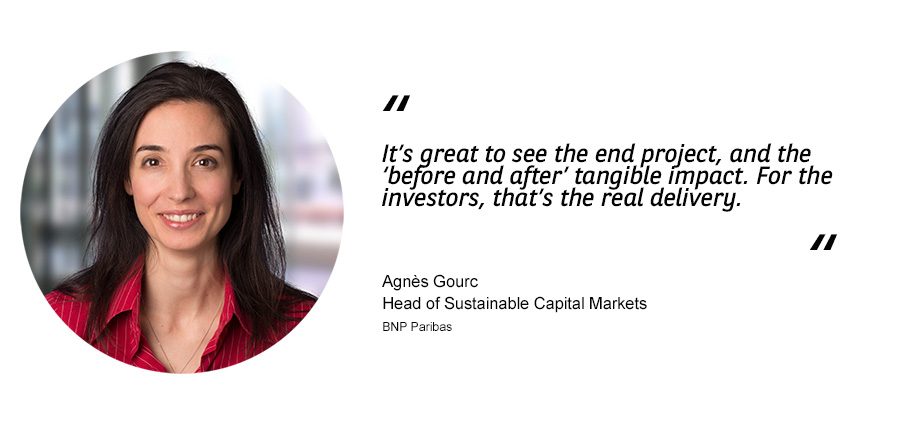This article was first published in Environmental Finance
The market is moving very quickly and we aim to keep ahead of that: for example, earlier in the year we executed what we call a transition bond transaction for SNAM (an Italian gas utility), and we see those picking up in the market. We also recently did the first bank additional Tier 1 capital raise in a green bond format.
Compared with a conventional green bond, that required a lot of legal work and a lot of preparation, including ensuring the guarantor and investors were happy with all elements of the transaction.
In terms of demonstrating impact, that was the easier part: it’s great to see the end project, and the ‘before and after’ tangible impact. For the investors, that’s the real delivery.
However, they are rising to the challenge very well. While it’s not plain sailing, it is still manageable and brings good results – and there are plenty of new sovereigns coming to the market.
These transactions create a really positive dynamic. Banks like to be regular issuers of bonds, including sustainability bonds, so it creates a push within the bank to originate more underlying business to refinance.

Also, the Technical Expert Group [of the European Commission] has made a few tweaks compared with the interim report. For example, it has abandoned a requirement for issuers to report the ratios of green to conventional bonds, as that could discourage issuers from taking their first steps towards improving their sustainability. They listened to comments from the market.
Environmental Finance: What is the focus of BNP Paribas’s green and sustainability bond business?
Agnès Gourc: There is a real breadth to the type, geographies and sectors of sustainability bond transactions we undertake. We try to apply what we believe to be our strong conventional bond platform to the sustainability business.The market is moving very quickly and we aim to keep ahead of that: for example, earlier in the year we executed what we call a transition bond transaction for SNAM (an Italian gas utility), and we see those picking up in the market. We also recently did the first bank additional Tier 1 capital raise in a green bond format.
EF: One of the more novel sustainability bonds BNP Paribas was involved in last year was the $95 million issue from the Tropical Landscapes Finance Facility, which combines rubber plantation management, conservation and rural livelihood management. What were the challenges involved in structuring the bond?
AG: The idea was to provide long-term financing to a project that is still somewhat risky. The challenge was to align all the parties involved and put together a structure that was investor-friendly. It was structured as a securitisation, with government agency USAID as a guarantor.Compared with a conventional green bond, that required a lot of legal work and a lot of preparation, including ensuring the guarantor and investors were happy with all elements of the transaction.
In terms of demonstrating impact, that was the easier part: it’s great to see the end project, and the ‘before and after’ tangible impact. For the investors, that’s the real delivery.
EF: The bank won Environmental Finance’s lead manager of the year for the corporate green bond market. What appetite are you seeing from corporates to issue green bonds?
AG: At BNP Paribas, we do a lot of business with corporates. We’re seeing new geographies ramping up, such as Germany, which only saw one debut green bond corporate transaction last year. Italy, which began to take off in 2018, is accelerating. Among Italian corporates, sustainability bonds are now widely accepted. Compared with the market when we started in 2014, it’s really encouraging that it’s becoming so dynamic.EF: The bank also took the award for sovereign bond lead manager. What are the challenges sovereign issuers face when they approach the green bond market?
AG: Most corporates tend to address one category of the Green Bond Principles. With sovereigns, they can often issue against all of them. A key element for an issuer is being efficient in how they approach the transaction. That requires very strong coordination between the issuing department – the debt management office – and the relevant ministries. There is often a huge amount of information.However, they are rising to the challenge very well. While it’s not plain sailing, it is still manageable and brings good results – and there are plenty of new sovereigns coming to the market.
EF: BNP Paribas also scored a success in the lead manager, bank sustainability bond category. How are financial institutions approaching sustainability bond issuance?
AG: As with sovereigns, when banks set up a green bond framework, it can touch on so many different categories it is quite an achievement for financial institutions to issue in this market. They have to change their internal procedures quite drastically and put all the reporting in place. In the majority of cases, they are issuing bonds against projects where they are the intermediary, so their reporting has an additional layer of complexity.These transactions create a really positive dynamic. Banks like to be regular issuers of bonds, including sustainability bonds, so it creates a push within the bank to originate more underlying business to refinance.

EF: What are your expectations for the evolution of the sustainability bond market?
AG: There are a lot of new areas for sustainability bonds to finance that are being discussed – such as transition bonds, for example. We are looking at a broader range of issuers, carbon- or resource-intensive companies, which could use transition bonds to improve their environmental performance. We are having lots of conversations on opex (operational expenses) versus capex (capital expenditures), and which types of instruments could be used.EF: What impact do you expect the EU’s green bond standard to have on the market’s growth?
AG: There are various views in the market on that question! The way I read it, it’s a translation of best market practice in Europe today. We have to recognise that, in some markets, you might face some challenges applying it. However, if we have more clarity in the market, including through the EU Taxonomy, it makes life easier for everyone. Some issuers may find it difficult at first to address all of its points, but I don’t think there’s anything in the text that’s out of reach.Also, the Technical Expert Group [of the European Commission] has made a few tweaks compared with the interim report. For example, it has abandoned a requirement for issuers to report the ratios of green to conventional bonds, as that could discourage issuers from taking their first steps towards improving their sustainability. They listened to comments from the market.
